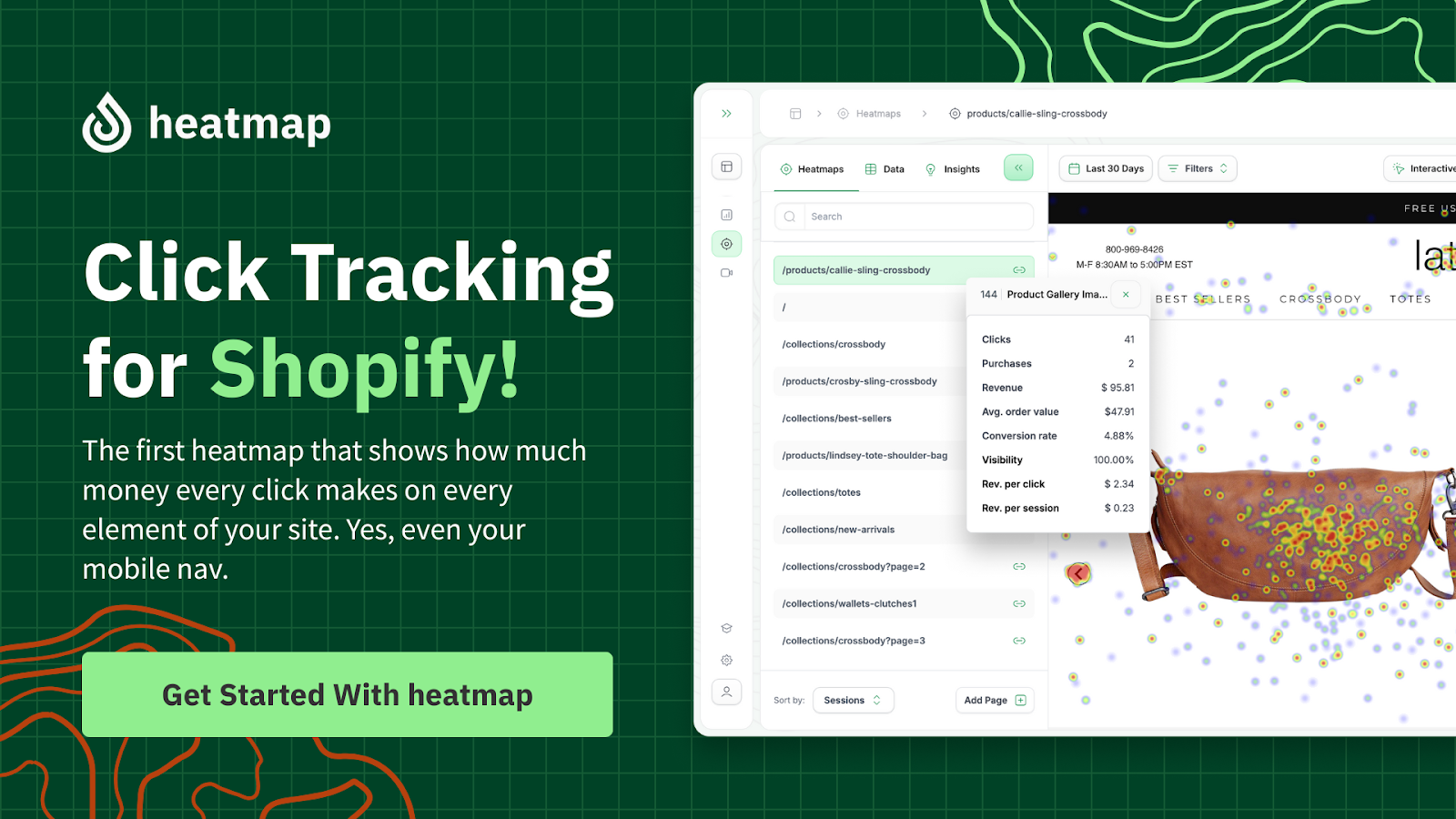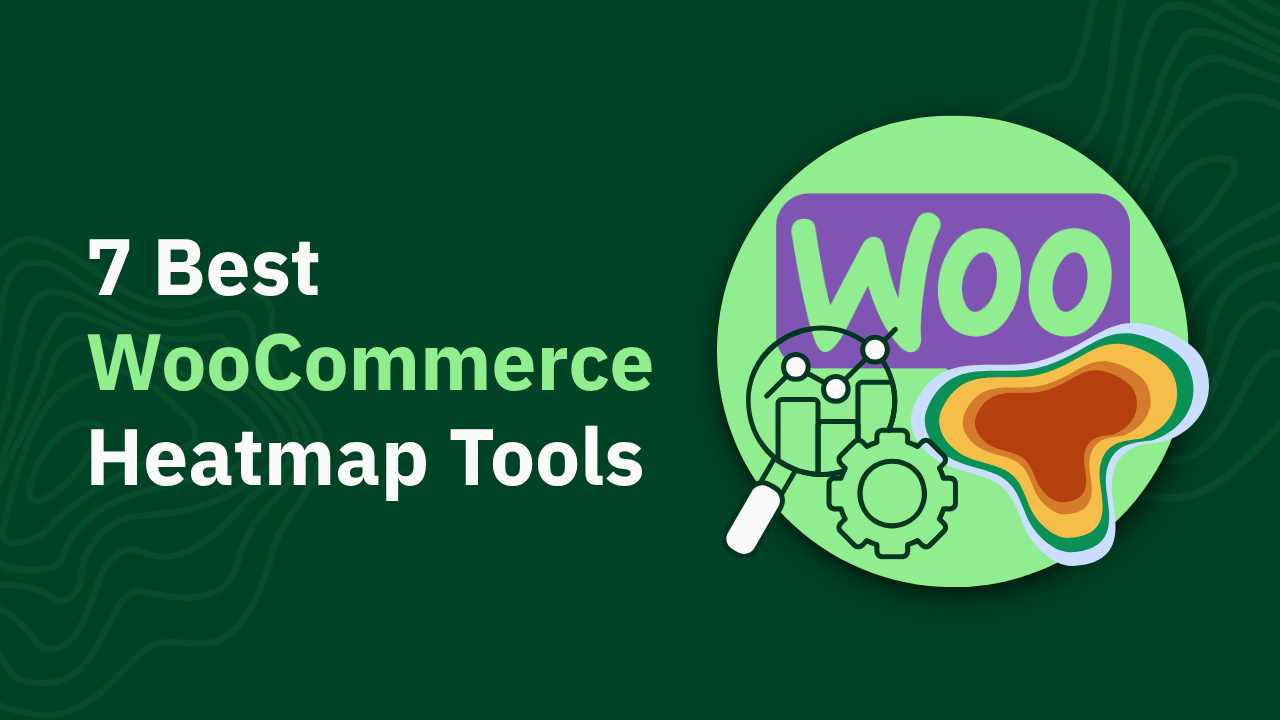The 9 Best Tools For Smarter Ecommerce Insights

Maximize your store’s profit potential with the best ecommerce analytics tools by Heatmap. Get smarter insights, fix friction points that skyrocket revenue.

Key Takeaways:
- Link User Actions to Revenue Outcomes: Leveraging advanced ecommerce analytics can directly link user interactions to revenue, driving more precise and profitable decision-making.
- Prioritize Tools With High-Impact Capabilities: The top ecommerce analytics tools offer revenue attribution, seamless integration, and actionable insights that enhance site performance and conversion rates.
- Focus on Metrics That Drive Growth: Focus on revenue-impactful metrics, optimize user journeys, and regularly update your strategies based on insightful data to avoid common pitfalls.
At Heatmap, we show you what numbers alone can’t. Our platform connects user behavior to actual revenue so you can see exactly what drives performance on your site. We help ecommerce teams go beyond assumptions and act on what truly matters. With fast setup, clear visuals, and precision insights, brands trust us to sharpen their decision-making and increase conversions where it counts most, on the page.
With ecommerce analytics tools evolving rapidly, knowing which ones deliver real value is key. From screen recordings to revenue attribution, the landscape is full of platforms promising clarity. The strongest tools collect data and help you translate it into smarter decisions, faster iterations, and better customer journeys. Knowing which tools consistently stand out and why others fall short is worth knowing if you want to grow efficiently.
In this blog, we will explore nine of the most effective ecommerce analytics tools. These tools help brands track behavior, measure performance, and turn user insights into higher revenue.

Why Traditional Analytics Tools Aren't Enough
You’re used to dashboards crammed with numbers, bounce rates, session counts, and pretty clickmaps. But here’s the hard truth: old-school analytics tools leave serious money on the table. Traditional site analytics stop at superficial engagement metrics. They’ll tell you that 40% of traffic scrolled past the hero image or that people are hammering your “Add to Cart” button. But they can’t show whether those actions resulted in actual revenue.
The Gap Between Behavior And Business Outcomes
The disconnect? These tools see users as data points, not as buyers. You get lost in averages and percentages instead of pinpointing the real question every e-commerce brand should be asking: Which specific clicks, taps, and scrolls are driving actual sales?
Superficial Metrics Lead To Surface-level Decisions
It doesn’t matter if you unlock heatmaps or set up dozens of goals; your optimization decisions are half-blind without clear attribution to revenue. You can make things prettier, easier, and even more “engaging,” but will it move the needle where it counts: your bottom line?
Optimization Should Serve Profit, Not Vanity
Digital shelf space is expensive. Every product photo, every CTA, and every design tweak should earn its keep. Relying on traditional analytics is like looking at a map with half the streets missing. You need to tie user behavior directly to profit if you want true clarity on what actually works. Otherwise, you’re optimizing for engagement, not earnings, and that’s a risk no data-driven retailer should take.

Key Benefits Of An Advanced E-Commerce Analytics Platform
Let’s get straight: data is only as valuable as the revenue it helps you unlock. Advanced ecommerce analytics tools let you cut through the noise by showing how every user interaction affects your bottom line. Forget vanity metrics; what you want are actionable insights that drive actual business growth.
See Revenue Behind Every Interaction
You’ll tap into revenue-first clarity. Instead of guessing which product pages or categories perform best, you see the complex numbers linked to every click, scroll, or tap. You can instantly identify your biggest revenue drivers and spot underperformers before they enter your margins.
Fix Friction With Precision
Advanced analytics deliver hyper-intuitive optimization. You spot friction points and “dead zones” where customers drop off, then fix them fast. No more distant hunches or slow decision cycles. These tools pinpoint the exact on-site elements holding you back, empowering you to double down on what works and ditch what doesn’t.
Act Faster With Less Effort
Next comes smarter growth in less time. Rich integrations and seamless setups mean you’re not wrestling with clunky dashboards or messy spreadsheets. You can move from insight to action in minutes, not weeks. For teams juggling paid campaigns, landing page tweaks, and A/B testing, this speed wins customers (and boardroom buy-in).
Built For Modern Performance And Compliance
Finally, advanced analytics safeguards data privacy and site speed. With best-in-class compliance features and lightweight code, you keep your store lightning-fast and customer trust sky-high, all while extracting maximum insight.
In fierce ecommerce markets, standing still is surrender. The dominant retailers make every decision with sharper, revenue-focused data at their fingertips.
The 9 Best Tools For Smarter Ecommerce Insights
Choosing the right ecommerce analytics tools can transform how you understand customer behavior and make decisions. From real-time revenue attribution to pinpointing friction on key pages, the right platform helps you move faster, optimize smarter, and grow more confidently without relying on guesswork.
Check out the top eight here:
1. Heatmap – Revenue-Based User Behavior Analytics
Heatmap stands out by connecting every user interaction, click, scroll, hover, to actual revenue. Unlike traditional tools, it overlays real-time revenue data on visual heatmaps, showing which on-page elements directly generate or lose money. E-commerce teams can filter insights by traffic source, device type, or customer segment and even watch session recordings with revenue attribution included. With AI-powered recommendations trained on over 300,000 online stores and a setup under 5 minutes, Heatmap gives conversion teams data they can act on immediately, with full compliance and no performance impact.
2. Hotjar
Hotjar’s heatmaps, session recordings, and feedback widgets strip away the guesswork by showing how shoppers interact with your site. Get inside your audience’s head, spot friction points, and gather direct feedback that can instantly inform smarter CRO moves.
3. Klaviyo
Klaviyo cements its place in the analytics lineup with robust revenue attribution. From one dashboard, you can see which campaigns move the needle, understand lifetime value by segment, and slice your data to pinpoint high-value cohorts.
4. ThoughtMetric
ThoughtMetric gives e-commerce teams clear, multi-touch revenue attribution across every channel. Break down results by campaign, creative, customer, and product to see what drives sales. Built-in CAPI integrations and server-side tracking keep data accurate, and easy setup gets you running in minutes.
5. Mixpanel
Mixpanel zeroes in on user flows and advanced cohorts and provides powerful funnels. You’ll see precisely where shoppers drop, who keeps coming back, and which features fuel retention. If you’re obsessed with customer lifecycle insights, this is your tool.
6. Triple Whale
All your multichannel data is blended into one crystal-clear picture. Triple Whale brings ROAS, ad spend, and store performance together, linking paid efforts to profit. If you’re scaling with aggressive paid media, this clarity keeps budgets efficient and margins fat.
7. Matomo
Matomo puts you in control of every data point and metric, offering customizable dashboards and in-depth ecommerce tracking. Plus, there’s no data sampling, and no surprise compliance headaches down the road.
8. FullStory
If digital experience is your obsession, FullStory delivers. It combines robust session replay with actionable analytics and frustration detection. Track every tap, scroll, and rage click, then tie those moments directly to conversion or abandonment. If you want the complete story behind every sale, this is how you get it.
9. TheKollab
To bridge the gap between user actions and actual business results, a more holistic approach to analytics is required. Traditional tools often fall short of showing how individual interactions impact revenue, leaving businesses in the dark when it comes to making informed decisions that truly drive growth. By integrating platforms that track behavior with clear revenue attribution, e-commerce brands can uncover actionable insights. For example, The Kollab offers a solution that moves beyond surface-level metrics by providing in-depth analyses that link user actions directly to sales outcomes, helping brands optimize their strategies based on what truly matters. This approach ensures that every decision is rooted in data that directly affects the bottom line.

Comparing E-commerce Analytics Tools: What To Look For
Picking the right ecommerce analytics software can feel like staring down a rack of nearly identical black t-shirts until you know what really matters. Whether running a lean DTC shop or scaling up a multi-brand operation, mediocre data will always cap your growth. So, when evaluating your options, skip the fluff and drill into the essentials that drive revenue, not just traffic.
Revenue Attribution, Not Guesswork
Most tools love surfacing shiny charts: page views, clicks, time-on-site. But you're left playing a dangerous guessing game unless you can connect those actions directly to transactions. Prioritize platforms that show exactly which elements (not just which pages) turn visitors into buyers, and put a dollar sign to each.
Ease Of Integration
Your stack should work for you, not the other way around. Look for solutions that match your existing CMS, ecommerce platform, A/B testing setups, and marketing tools. The goal? Fast onboarding, minimal dev resources, and no site speed penalties.
Actionable Recommendations
Data is only as good as the decisions you can make from it. Top-tier tools don’t just vomit up numbers; they surface insights and prescribe next steps. If you’re stuck making sense of endless dashboards, keep looking.
CRO-First Mindset
Any ecommerce analytics platform worth its seat at the table should be built around conversion rate optimization. That means highlighting opportunities to drive revenue per session, not just tidy-looking metrics for your next team meeting.
Visual Insights
Heatmaps, scrollmaps, and session recordings aren’t nice-to-haves—they’re non-negotiable if you want a real-world view of shopper behavior. Prioritize platforms that help you see user journeys in living color, not just lines on a graph.
Privacy And Performance Compliance
GDPR-compliance, lightweight code, and respect for user privacy are deal-breakers. The last thing you want is to sacrifice site speed or compliance for analytics.
Common Mistakes To Avoid With Analytics Tools
Let’s get real: the promise of ecommerce analytics tools is huge: insights, optimization, and maybe even overnight revenue growth. But even the best platforms can lead you down the wrong path if you’re tripping over common mistakes.
Here’s where plenty of smart teams miss the mark:
- Chasing Vanity Metrics Instead of Revenue: Clicks, pageviews, even bounce rates, they’re flashy, but if you’re not tying your insights directly to dollars, you’re missing the point. The only metrics that matter are the ones that impact revenue and growth.
- Overcomplicating Setup and Tracking: Yes, robust data is valuable. But your insights get muddy quickly if you’re layering on endless goals, convoluted funnels, and custom events just because you can. Start clean. Track what truly matters for conversions and your bottom line.
- Ignoring the Customer Journey: Looking at analytics in isolation, single pages, and specific product clicks can blind you to how users actually shop. Siloed data means missed opportunities. Analyze how a shopper moves from the homepage to checkout and which touchpoints drive the buy.
- Setting and Forgetting: Analytics isn’t one-and-done. Businesses and customers change. If you’re not revisiting your setups and acting on new data regularly, you’re running your store on yesterday’s instincts.
- Failing to Bridge Data and Action: Collecting insights is only half the job. If your team isn’t using that info to test, iterate, and optimize, you’ve got pretty charts, not progress. Ensure every team member knows how to turn insights into revenue-boosting action.
The point is that good analytics should make your road to more sales clearer, not more confusing. Strip out the noise, focus on what drives revenue, and never settle for insights that don’t move the needle.

Final Thoughts
The era of guesswork is done. E-commerce is a high-stakes game; every click, scroll, and tap on your site is key to revenue growth. That’s why choosing the right ecommerce data analytics tools is the strongest lever you can pull to hit your targets, outsmart competitors, and fuel bottom-line results.
Want numbers you can trust? Choose tools that make revenue the heart of every insight. Don’t settle for vague engagement stats. Look for platforms, like Heatmap, that connect every customer action to real dollars, spotlight your true moneymakers, and hand you precise action steps proven to boost Revenue Per Session.
Read also:
- Heatmapping 101: How It Works And Why Your Website Needs It
- How To Read A Heat Map
- What Is Customer Effort Score? And How Heatmaps Can Improve It
Frequently Asked Questions About E-commerce Analytics Tools
What features should I look for in an e-commerce insight tool?
Don’t settle for basic click-and-scroll data. Look for actionable revenue attribution; you can see exactly which clicks, taps, and scrolls lead to actual sales. Real-time analytics, conversion-focused heatmaps, advanced segmentation, funnel analysis, and easy integration with your stack are also non-negotiables. The easier it is to connect website actions to cash in your bank account, the better.
How do tools like Google Analytics help with e-commerce?
Google Analytics can show you top-level website traffic, popular pages, and some sales conversion data. It’s solid for tracking visitor trends and building broad customer funnels. But if you’re chasing high-impact optimizations based on what makes you money, traditional tools stop short; most don’t break out individual on-site interactions by revenue. That’s where ecommerce-specific platforms push the envelope.
Is there a difference between general analytics tools and e-commerce-specific ones?
Absolutely. General analytics platforms give you traffic data, engagement, and KPIs for any site. E-commerce-focused analytics solutions (like Heatmap.com) are engineered to show which site interactions drive product clicks, cart additions, and completed checkouts and tie each action to actual revenue. If you’re running a store, don’t trust your growth to analytics built for blogs and portfolios.
Can e-commerce insight tools help with customer segmentation?
100%. The right tools let you segment by behavior, device, geography, purchase history, and more. That way, you’re never guessing; you always know which audience slice responds best to offers, layout tweaks, or new landing pages. With segmented insights, you’ll spend less on wasted campaigns and unlock more revenue from every traffic channel.
How can analytics tools improve my online sales?
Simple: showing where customers drop off, hesitate, or click “buy.” With this level of detail, you don’t have to guess what’s working; you make precise changes that boost conversions and average order value. Solutions like Heatmap go further with AI-powered CRO recommendations, so you run every test with high confidence, and it’ll lift revenue.
How can I track customer behavior on my e-commerce site?
Start by installing a revenue-focused analytics platform that ties on-site actions to sales. Tools like Heatmap offer heatmaps, scrollmaps, and screen recordings, and every tap, hover, and scroll is mapped to actual dollars. Combine this with conversion funnels, event tracking, and A/B testing integrations, and you get the complete picture of what your customers love (and what’s costing you sales).
How You Can Do It:
1: Download heatmap
2: Wait for 5k sessions
3: Reorganize products based on the highest revenue per session from top left to bottom right.

Founder of heatmap, SplitTesting.com, and multiple ecommerce brands. Lifelong optimizer, CRO-lover, and data nerd.
You made it all the way down here?
Might as well give us a shot, right? It'll change the way you approach CRO. We promise. In fact, our friend Nate over at Original Grain used element-level revenue data from heatmap to identify high-impact areas of his website to test, resulting in a 17% lift in Revenue per Session while scaling site traffic by 43%. Be like Nate. Try heatmap today.





